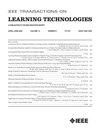HSVRS: A Virtual Reality System of the Hide-and-Seek Game to Enhance Gaze Fixation Ability for Autistic Children
IF 4.9
3区 教育学
Q2 COMPUTER SCIENCE, INTERDISCIPLINARY APPLICATIONS
引用次数: 0
Abstract
Numerous children diagnosed with autism spectrum disorder (ASD) exhibit abnormal eye gaze pattern in communication and social interaction. In this study, we aim to investigate the effectiveness of the hide-and-seek virtual reality system (HSVRS) in improving gaze fixation abilities in children with ASD. Our hypothesis is that engaging in a hide-and-seek game within a virtual environment, particularly with a customized avatar resembling a familiar figure, would significantly enhance gaze fixation skills compared to traditional interventions without supplementary virtual reality (VR) intervention. In total, 36 children with ASD were involved in this pilot study in three groups: the avatar customized group, the avatar uncustomized group, and the control group. The control group only received human intervention, while the avatar group received additional VR-assisted interventions. The effect of HSVRS was measured by a six-point Likert subjective questionnaire and demonstrated significant improvements in gaze fixation abilities in the VR-assisted intervention groups compared to the control group (HSVRS:增强自闭症儿童凝视固定能力的捉迷藏游戏虚拟现实系统
许多被诊断患有自闭症谱系障碍(ASD)的儿童在交流和社交中表现出异常的注视模式。在本研究中,我们旨在调查捉迷藏虚拟现实系统(HSVRS)在提高自闭症儿童凝视固定能力方面的有效性。我们的假设是,与没有辅助虚拟现实(VR)干预的传统干预相比,在虚拟环境中参与捉迷藏游戏,尤其是与类似熟悉人物的定制化身一起参与游戏,将显著提高凝视固定能力。共有 36 名患有 ASD 的儿童参与了这项试验研究,分为三组:定制头像组、未定制头像组和对照组。对照组只接受人工干预,而头像组则接受额外的 VR 辅助干预。HSVRS 的效果通过六点李克特主观问卷进行测量,结果显示,与对照组相比,VR 辅助干预组的凝视固定能力有显著提高($P$ = 0.006,0.001)。此外,头像定制组在与熟悉的头像互动后,凝视固定指标也有了明显提高($P$ = 0.036, 0.005, 0.001)。实验结果表明,利用虚拟现实技术辅助常规干预,对提高患有自闭症的幼儿的凝视固定能力非常有效。
本文章由计算机程序翻译,如有差异,请以英文原文为准。
求助全文
约1分钟内获得全文
求助全文
来源期刊

IEEE Transactions on Learning Technologies
COMPUTER SCIENCE, INTERDISCIPLINARY APPLICATIONS-
CiteScore
7.50
自引率
5.40%
发文量
82
审稿时长
>12 weeks
期刊介绍:
The IEEE Transactions on Learning Technologies covers all advances in learning technologies and their applications, including but not limited to the following topics: innovative online learning systems; intelligent tutors; educational games; simulation systems for education and training; collaborative learning tools; learning with mobile devices; wearable devices and interfaces for learning; personalized and adaptive learning systems; tools for formative and summative assessment; tools for learning analytics and educational data mining; ontologies for learning systems; standards and web services that support learning; authoring tools for learning materials; computer support for peer tutoring; learning via computer-mediated inquiry, field, and lab work; social learning techniques; social networks and infrastructures for learning and knowledge sharing; and creation and management of learning objects.
 求助内容:
求助内容: 应助结果提醒方式:
应助结果提醒方式:


